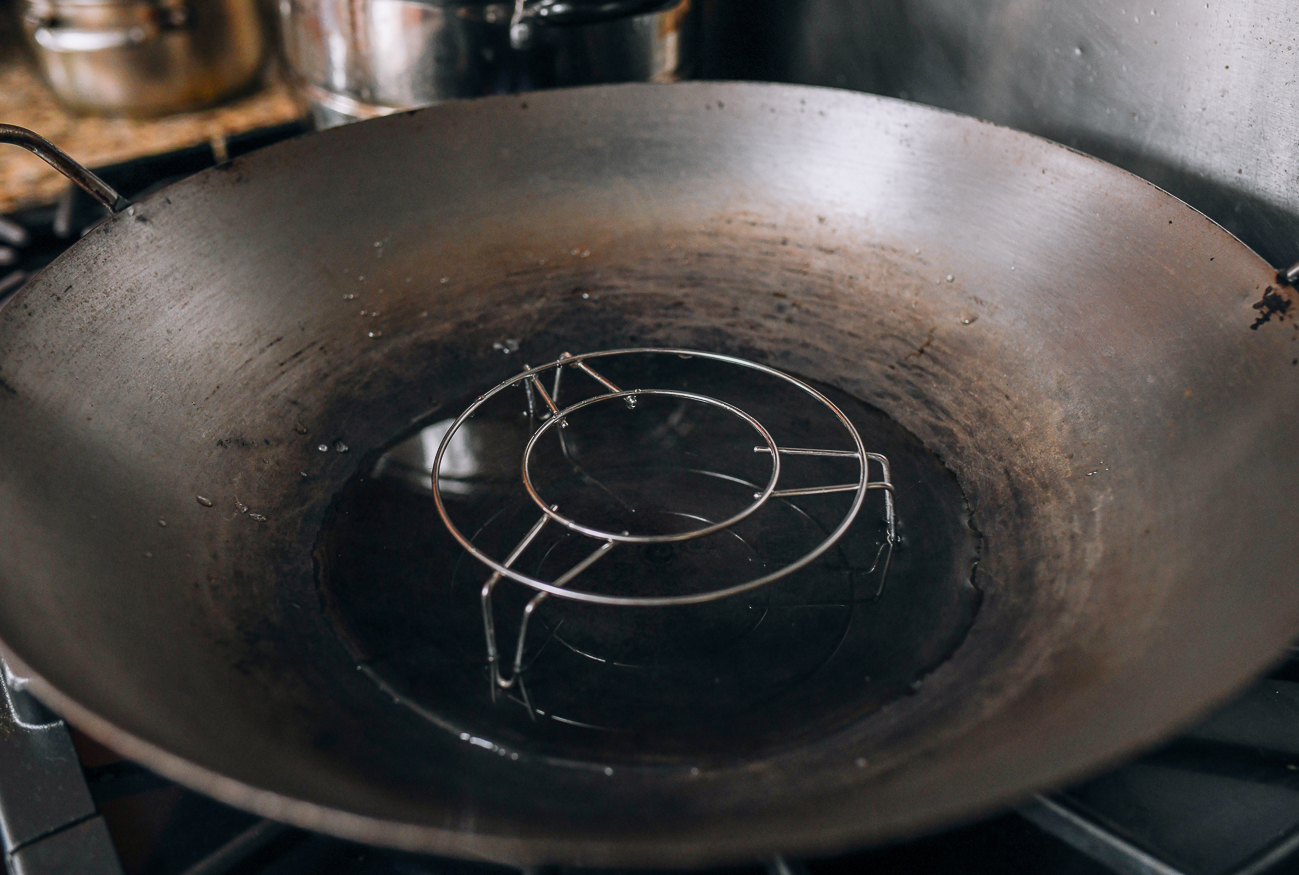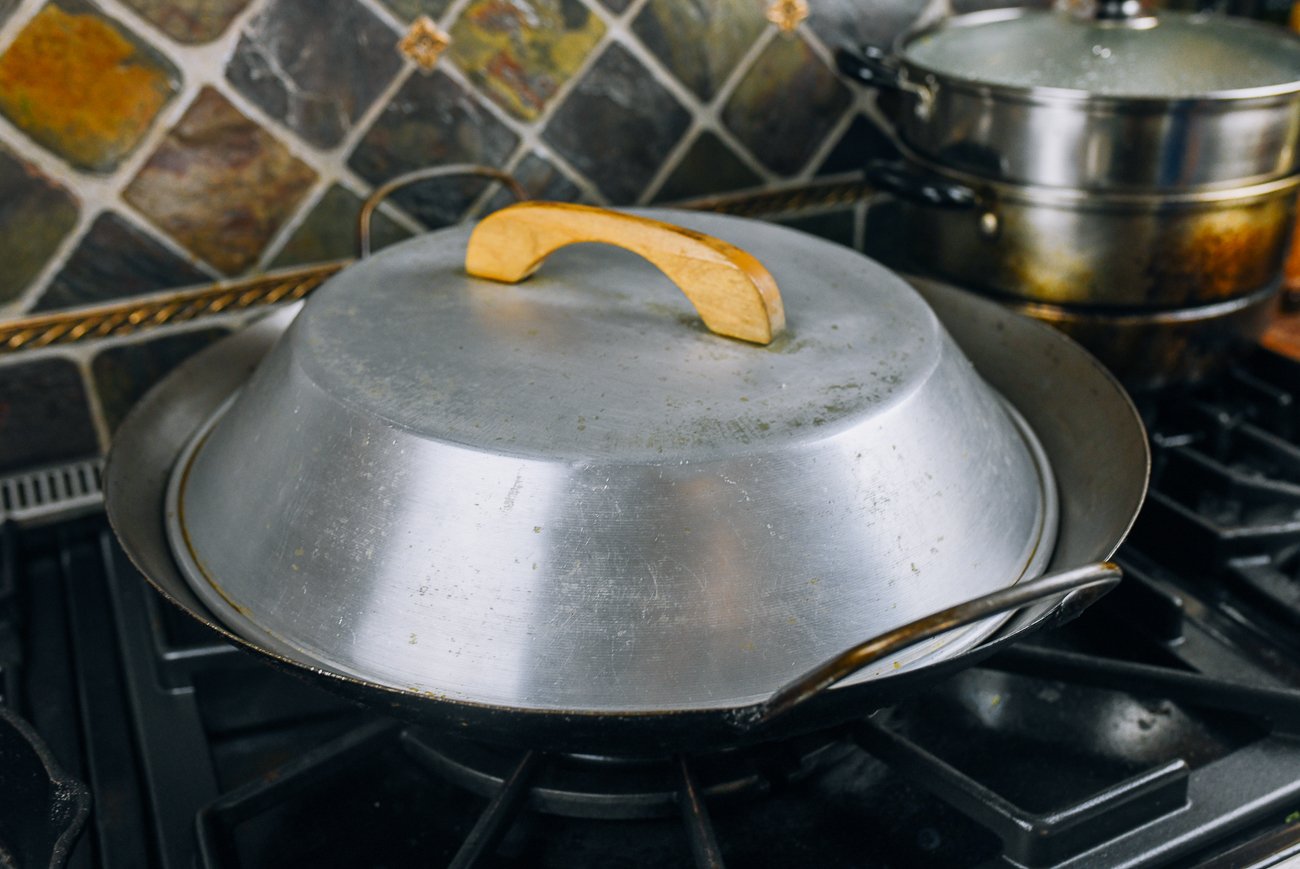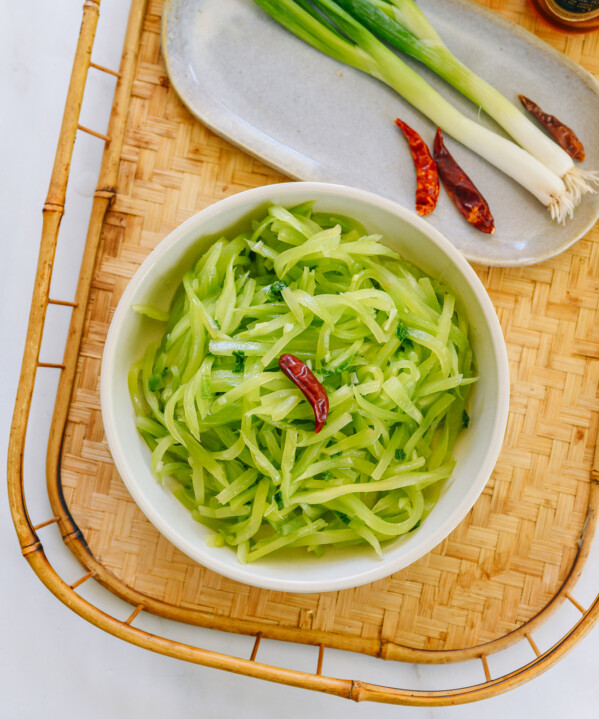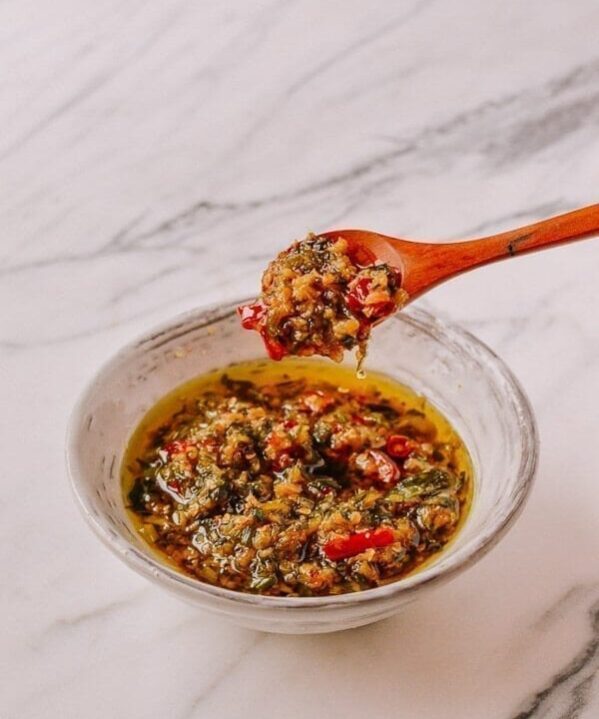This Spaghetti Squash Salad with Scallion Oil can serve as an appetizer or a unique side dish. Serve it cold or at room temperature. It goes well with a Chinese spread or even a weeknight piece of chicken and side of grains and greens! I’m really excited to share this recipe with you all.
This is a type of dish in Chinese cuisine called liángcài (凉菜), which translates to “cold dishes.” It’s an entire category of refreshing salads (you may see the dishes described in Chinese as liángbàn (凉拌), which means “cold tossed.” They start the meal and whet the appetite.
A Surprising Recipe for Spaghetti Squash
It’s been a long time since I’ve been so impressed by a dish while eating out. The girls will tell you that I’m hard to impress at even the nicest restaurants!
But the taste and texture of this everyday spaghetti squash totally astonished me during a recent trip that Bill and I took to Shanghai, Nanjing, and Yangzhou.
Cold tossed dishes can be made with many ingredients, like cucumbers, wood ears, celtuce, and bamboo shoots, but this menu had “golden melon” (金瓜) listed in the appetizer/starters section.
At first, I didn’t know what it was, and I knew I had to try it. As it turned out, it’s the popular spaghetti squash that we all know of in the West as a substitute for spaghetti noodles.
In truth, the real magic of spaghetti squash isn’t as a substitute for carbs, but as a delicious item all on its own! I was both stupefied and pleasantly surprised, as it is so good!!! Crunchy, refreshing and tasty.

Have You Ever Seen Spaghetti Squash on a Chinese Menu?
The combination of spaghetti squash with Chinese flavors is definitely new to me. I came to find out it’s considered a specialty from Chongming (崇明), an island neighboring Shanghai that serves as a huge produce supplier to the Shanghai area.
Because of spaghetti squash’s beautiful yellow outer and inner color, it is intuitively being called “golden melon,” a very catchy and auspicious name indeed.
With its golden strands and crunchy texture, making it into a refreshing cold Chinese appetizer is a match made in heaven. Chinese people love crunchy and cool textures to start the meal, particularly during the warmer months.
According to my research, China has been cultivating spaghetti squash since the Ming dynasty, so I’m not sure why it’s only now that I am seeing it on Chinese menus.
I’ve noticed that Asian supermarkets in the US also sell spaghetti squashes, but I always thought it was just a quirk to cater to non-Chinese shoppers. So now I’m so curious to know what other Asian folks are doing with spaghetti squash. Please share in the comments!
At least from now on, I know what I will be doing with it!
VIDEO: Watch How This Dish Gets Made!
Recipe Notes
I took a video while sampling this dish at the restaurant. That version included jellyfish, which adds more crunchiness to the dish, but this recipe is both vegan and just as good without it.
Add-ons like jellyfish and/or shredded cucumber will definitely give the dish more texture, but I like it just as written. You can also add in a drizzle of our chili oil to punch up the flavor. Dress it however you like.
You can easily make it ahead, as it is delicious cold. It should last for a few days in the refrigerator.
Just keep in mind that the longer it sits, it may lose its crunch, though it should hold up better than something like seasoned cucumbers, which weep water as soon you season them. (Speaking of, keep that in mind if you want to add shredded cucumbers to this dish.)
Recipe Instructions
Take your lengthwise half of spaghetti squash, and scoop out the seeds. (Set aside the other half for another time or another dish).


Set up a steamer with water. (Use a metal steamer, or a covered wok or pot that will accommodate a large piece of spaghetti squash along with a steaming rack.) Bring it to a boil.


Once the water is boiling, steam the hollowed out squash for 12-13 minutes. (Note that we made a double recipe in the photos. That is why we’re steaming the whole squash instead of just half.)

When a fork can poke through the squash, it’s done. (If you have a smaller squash, reduce the cooking time.) The fork should just pierce through the flesh of the squash. Don’t over-steam it, as you want it to have a slightly crunchy, crisp-tender texture instead of a mushy texture.

While the squash is cooking, prepare a cold water bath. (No need for ice, just use the coldest setting on your tap.) Once the squash is done steaming, transfer it to the water bath to stop the cooking process and cool it down.
Once it’s cool enough to handle, run a fork around the edges of the spaghetti squash to separate the flesh from the hard skin.


Use your fingers to break the chunks apart into strands of spaghetti squash.

Then use your hands to squeeze any liquid out of the spaghetti squash—a handful at a time—transferring it to a mixing bowl as you go.


Wash the scallions, and pat them dry. Cut them on a diagonal into 1-inch lengths, separating the white parts from the green parts.
Heat the neutral oil in a small pot over medium low heat. Add the white parts of the scallions and the Sichuan peppercorns. Cook for 10-15 minutes until the oil is fragrant, the scallions are golden, and the peppercorns are a few shades darker. Take care not to burn the aromatics, or the flavor will be bitter. Remove from the heat, and cool.

To the spaghetti squash, add salt, sesame oil, white pepper powder, MSG, the green parts of the scallions. Add the infused oil, pouring it through a fine-meshed strainer or using a slotted spoon to hold back the solids. Mix everything well, cover, and let the flavors meld for 10-15 minutes in the refrigerator before serving. Serve chilled or at room temperature.

Spaghetti Squash Salad with Scallion Oil

Ingredients
- ½ of one large spaghetti squash (1½ pounds spaghetti squash)
- 2 scallions
- ¼ cup neutral oil (such as canola, vegetable, or avocado oil)
- 1 tablespoon Sichuan peppercorns
- 1 teaspoon salt (or to taste)
- 1 teaspoon sesame oil
- ⅛ teaspoon white pepper
- 1 pinch MSG (optional)
Instructions
- Take your lengthwise half of spaghetti squash, and scoop out the seeds. (Set aside the other half for another time or another dish). Set up a steamer with water (either a metal steamer, or a covered wok or pot that will accommodate a large piece of spaghetti squash along with a steaming rack), and bring it to a boil.
- Once the water is boiling, steam the hollowed out squash for 12-13 minutes. It’s done once you can poke a fork through (reduce the cooking time if your squash is smaller). The fork should just pierce through the flesh of the squash—don’t oversteam it, as you want it to have a slightly crunchy, crisp-tender texture instead of a mushy texture.
- While the squash is cooking, prepare a cold water bath (no need for ice, just use the coldest setting on your tap). Once the spaghetti squash is done steaming, transfer it to the water bath to stop the cooking process and cool it down.
- Once it’s cool enough to handle, run a fork around the edges of the spaghetti squash to separate the flesh from the hard skin. Use your fingers to break the chunks apart into strands of spaghetti squash. Then use your hands to squeeze any liquid out of the spaghetti squash—a handful at a time—transferring it to a mixing bowl as you go.
- Wash the scallions, and pat them dry. Cut them on a diagonal into 1-inch lengths, separating the white parts from the green parts.
- Heat the neutral oil in a small pot over medium low heat. Add the white parts of the scallions and the Sichuan peppercorns. Cook for 10-15 minutes until the oil is fragrant, the scallions are golden, and the peppercorns are a few shades darker. Take care not to burn the aromatics, or the flavor will be bitter. Remove from the heat, and cool.
- To the spaghetti squash, add salt, sesame oil, white pepper powder, MSG, the green parts of the scallions. Add the infused oil, pouring it through a fine-meshed strainer or using a slotted spoon to hold back the solids. Mix everything well, cover, and let the flavors meld for 10-15 minutes in the refrigerator before serving. Serve chilled or at room temperature.




